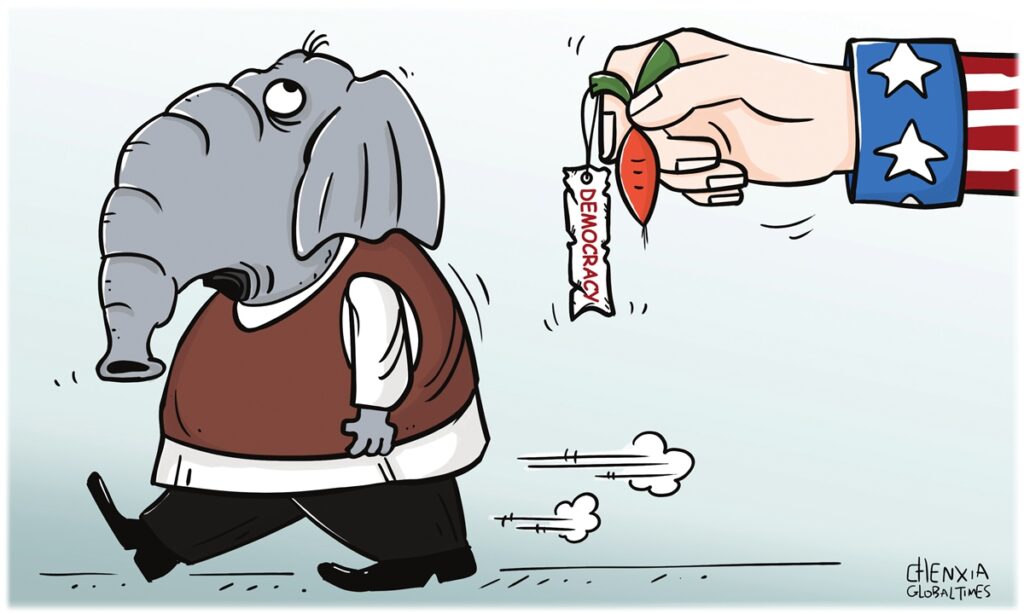As India overtook the UK and became the fifth largest economy in the world, the US and Western media have seized the opportunity to build momentum for a new round of rhetoric of “India is replacing China,” saying that due to the accelerated export of low-cost labor-intensive products such as Christmas decorations to the US, India is to become “the next China.” Although similar topics have been hyped for many years, in the context of the recent Quad senior officials’ meeting, the US-India bilateral trade negotiations, the Indo-Pacific Economic Framework (IPEF) ministerial meeting, and the India-Japan “2+2” meeting, this round of hype has created a public opinion trap of “India has completely turned to the US” and “India has made a choice between China and the US.”
It seems that India has entered its highlight. On the one hand, the US and the West have stepped up their efforts to rope in India, and India has entered several West-centric cliques, such as the Quad and the IPEF; on the other hand, India insists on maintaining friendly and cooperative relations with Russia, and it is also a member of BRICS and the Shanghai Cooperation Organization and maintains institutional communication and cooperation with China and other non-Western emerging economies. As a result, India has become one of the few major powers that can still gain advantages from both sides under the international environment that witnesses increasingly severe division and confrontation.
We are happy to see all countries including India achieve development and prosperity on the basis of pragmatic cooperation, which is also conducive to regional peace and stability. Both China and India adhere to the general direction of multilateralism, and share many propositions in the fields of maintaining peace and security, promoting economic recovery, improving global governance, and cooperating to fight the pandemic. Regarding the status of China-India relations, the leaders of the two countries have reached an important consensus: cooperation partners, no threat to each other, and development opportunities for each other. Therefore, China supports India to play a more constructive role in the international arena and more adequately express the positions and demands of developing countries, which will constrain the hegemony of the US and jointly promote more democratic international relations and a fairer international order.
Objectively speaking, India’s relatively comfortable diplomatic situation today is due to the fact that India’s insistence on independent strategic diplomacy has won more space for itself. Imagine, if India fully falls into the orbit of the geopolitical circles of the US and the West and becomes a vassal of Washington just like a “second Japan,” then how could India talk about its goal of becoming a powerful country? Besides, this is something that India’s national pride cannot allow.
In over half a century since its independence, India has gone through changes in the world, but it has somewhat insisted on strategic autonomy. This is like what China has experienced. But this is precisely what the arrogant and self-righteous Western elites cannot understand, or have not realized, and therefore their means of wooing India are actually disrespectful and even almsgiving. The mentality of the US and the West to take advantage of India is barely disguised. There is no doubt that if India really becomes the “next China,” Washington’s current “China threat theory” will be “perfectly” transformed into “India threat theory” overnight.
For example, the American and Western public opinion used empty promise of “replacing China” to repeatedly whet India’s appetite. But everyone is aware that although Washington is keen to push India to participate in various initiatives and dialogues targeting China, its core goal in the entire high-end manufacturing field is to bring the industry back to the US, rather than let India “replace China.” South Korean companies excluded from the US tax credit for electric vehicles serve a lesson for India. On the other hand, even though the US and the West want to keep China in check through India in the labor-intensive manufacturing sector, given China’s position in the industrial chain, further stalemate and industrial division with China may only put India behind countries like Vietnam and Bangladesh.
Public opinion in the US and the West is often times deliberately “promoting India and suppressing China.” They exaggerate India’s development achievements to overshadow China. They are excited about the divergences between China and India, and are trying their best to amplify and intensify them. But their blarneys to India are all belittling India.
They believe that such operation alone will make Indians feel good and willing to become Washington’s geopolitical tool. Sober-minded Indian strategists can easily see that Washington only pays lip service. American and Western elites have attempted to push China and India into a zero-sum game of “dragon and elephant competition” out of a Cold War mentality. However, as two ancient civilizations, two emerging economies, and two neighboring countries, the two countries share common interests that are far larger than their differences. The two sides have the wisdom and ability to achieve a “dance of dragon and elephant,” rather than consume each other.
After all, American and Western elites do not understand China, nor do they understand India. How could big countries like China and India, both of which expect the coming of an “Asian century,” dance to their playbook? Compared with the US and the West, we respect India’s independent foreign policy, and we are happy to see New Delhi’s strategic sobriety which makes it not easily fooled.
(Global Times)




